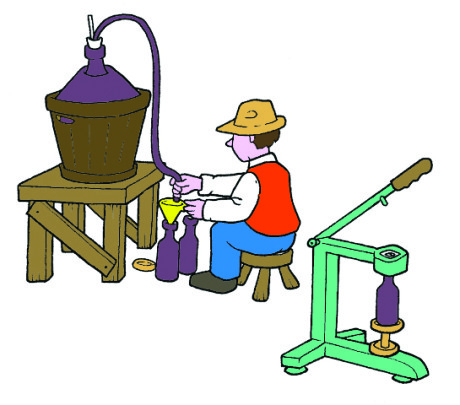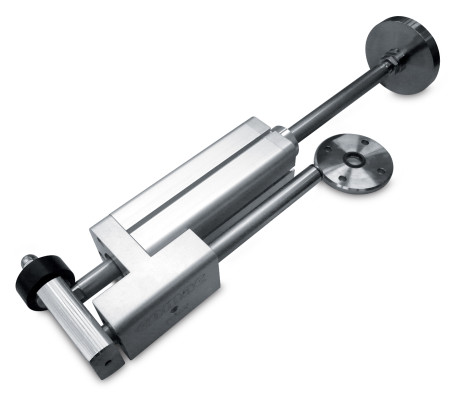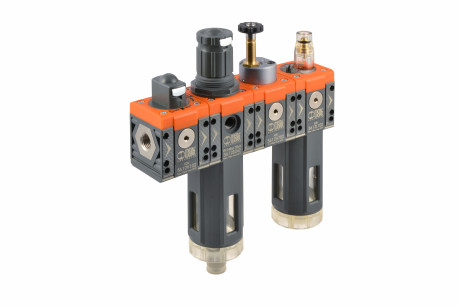The world of bottling machines and plants is very wide; the Italian industry holds a world prominence position in it. Pneumatic components to be used must satisfy requisites of reliability and, in many cases, of high speed to meet the exasperate productivity demanded by the market. The choice of materials and treatments must be suitable for the single zones of the plant, in contact or not with the food and/or with detergents. Today applications with electrical cylinders, instead of pneumatic ones, are emerging.

Perhaps those who do not operate in this sector, when thinking of bottling, imagine the situation represented in the opening drawing. Actually, still nowadays, some of us (I too), in the fresh environment of their cellar, relax while breathing the vapours that come out of wine while decanting it into thoroughly cleaned bottles. The industrial reality is very different. We generally deal with plants able to fill 3000 bottles per hour and in the mineral water sector up to 90,000 bottles per hour.
It is a very wide and diversified world. Solutions are different depending on the treated fluid: wine, water, milk, beverages, juices and oil. Besides, they are very different depending on the container: glass, polyethylene, aluminium and steel.
The bottling, or “filling”, is the central part of very complex processes. They start from the container production, for instance the creation of the PET bottle; in certain cases there is a sanitization phase; there is the real filling; the closure with the cap; there are the labelling and the packaging phases. All those steps must be carried out in conformity with food safety criteria, the certifications according to the rules of single States and, in short, quality. Flexibility is a requisite increasingly requested: it is necessary to manufacture plants that can be reconfigured for different liquids. However, containers can change, too, in compliance with designers’ dictates and the market expectations. Italy is leader in this sector. In Italy are headquartered some of the biggest world manufacturers of bottling plants and machines. Besides, are Italian also the hundreds or perhaps the thousands of small and medium companies that can design and produce the most various machines or special sub-assemblies.
Components for bottling
Are the pneumatic components for this sector different from those used elsewhere? Yes and no. We can also say “no” because if a component has been designed to perform dozen million cycles without needing maintenance, granting high reliability and in conformity with European and ISO standards, it is suitable for this sector as well as for others. However, we can also answer positively, because some characteristics are peculiar.

Speed is in fact a datum shared by several applications in this sector: it is often requested to execute numerous changeovers in one second. Even more important than speed, anyway, it is essential to assure that the changeover time does not vary along the years. Let us consider, for instance, a pneumatic solenoid valve that controls the motion of a cylinder. The valve opening time is, for instance, 10 milliseconds, then the cylinder motion occurs, for instance, in 50 milliseconds. The machine often has not time for the motion completion and, signalled by a sensor, to activate the successive phase. It is therefore necessary to plan ahead and to control the successive phase before the one in course is accomplished. At this stage, it is no more so important that the valve opening time is shorter or longer, because it can be anticipated, but it becomes very important that time remains as constant as possible, it is not influenced by the passing of years, by temperature, by the day of the week (the Monday morning syndrome is known, when we start again after a machine idle time period). Here the experience of the manufacturer of pneumatic components comes into play. We can consider for instance the HDM and CM solenoid valve isles by Metal Work from Concesio (Brescia, Italy). They are modular assemblies, which can contain a number of valves ranging from 1 to 64, of different type and with fittings for tubes from diameter 4 to diameter 10 mm. The switchover time, considering for instance the monostable 5/2 valves, is of 8 ms in operation and of 33 ms in reset. What matters, anyway, is that this time, after 50 million cycles, has variations of only ±3 milliseconds. To achieve this result, they worked hard on the design, on materials and especially on tribological aspects. The spool seals are of FKM/FPM, which is a material compatible with a big number of oils and detergents; the spool is made of aluminium treated with chemical nickel-plating and machine-polished, to grant high hardness (no wear) and low roughness (minimal friction). It is anyway the grease used that required more applied research activity: the one used for some years, which was called “high grip”, has the feature of adhering to the treated surfaces and of not being transported by liquids eventually entering the valve, no matter whether it is water, detergents or even glycol.
HDM and CM valve isles were designed 15 years ago but over the years they have undergone numerous ameliorative modifications, in order to enhance their reliability and, as explained, their functional constancy in time.
Pre-treatment of compressed air
The compressed air used in bottling plants must be adequately treated, if we want to protect valves and actuators. Metal Work relies on 5 series of air treatment groups, what in jargon we call FRL.

Among them, our customers prefer two. Syntesi is a modular group, available in two sizes, with attachments from 1/8” to 1”. It stands out for high performances in relation to its size, for the range completeness, for the flexibility and user-friendliness in configuring the groups with the various modules. For the applications needing very pure air, there is a 5 µm filter module followed by a purifying module, to retain oily particles, and finally an active carbon filter module to retain organic particles. Syntesi met such an immediate market success that another Italian manufacturer decided to copy it almost integrally.
The other air treatment group used in the bottling sector is ONE. While Syntesi is an example of modularity, on the contrary ONE is an example of integration: it is a single body that encloses in its inside all typical functions: filter, condensate exhaust, pressure regulator, manual valve, electric valve, pre-start valve, gauge, pressure switch and 4 air outlets. It can be panel-mounted because all regulation or maintenance functions are on the front side.
Actuators: not only stainless steel
Let us speak now of actuators. In several machines, stainless steel actuators lead the way, both standard cylinders, for instance according to the ISO15552 regulation and special tailor-made cylinders. In this ambit, Metal Work can offer the competence of Alfa Meccanica Group, precisely specialized in the design and manufacturing of special actuators made of various materials, including AISI 304, AISI 316 and 316L steel. Wherever, anyway, the stainless steel use is not compulsory, it is possible to exploit specific, less expensive, solutions. In collaboration with Brescia Engineering University, Metal Work has recently developed anti-corrosion ISO15552 cylinders. They are products exploiting aluminium alloys as base material, with a set of successive surface treatments that increase their resistance to corrosion. These products, besides passing saline mist tests, have proven to withstand acid environments up to pH=2 and basic environments up to pH=12. Anyway, are actuators in the bottling sector pneumatic only? No, of course. Apart from mechanic cam motions, ideal for high speeds and granted sequences, several motions are electrically controlled. We are illustrating an interesting case. There is a growing trend of beverages containing whole piece of fruit, not only liquid. This has caused some troubles to “filling” systems, because the density and the consistency of the product are not constant.

They have then introduced some dispensers, in other words big syringes where the plunger is operated by an electrically controlled cylinder. In this way, it is possible to control exactly the speed and the stroke of the plunger, irrespective of the type of bottled fluid. Metal Work has supplied numerous of these actuators, electrical cylinders of the Elektro ISO15552 series. Concerning motors, it is possible to choose either stepping or brushless motors. When the cylinder is mounted on a rotary part of the machine, it can be convenient to use a motor equipped with integrated drive, controlled by a fieldbus.
Conclusions
As seen, the pneumatics supplier is an important partner for machine manufacturers and must be able to design and to supply components, in certain cases standard and in others custom-made. Only in this way the performances and the reliability of plants can be optimized. Bottling machines, pneumatic components, electrical actuators are precisely the sectors where Italians’ mastery stands out.



